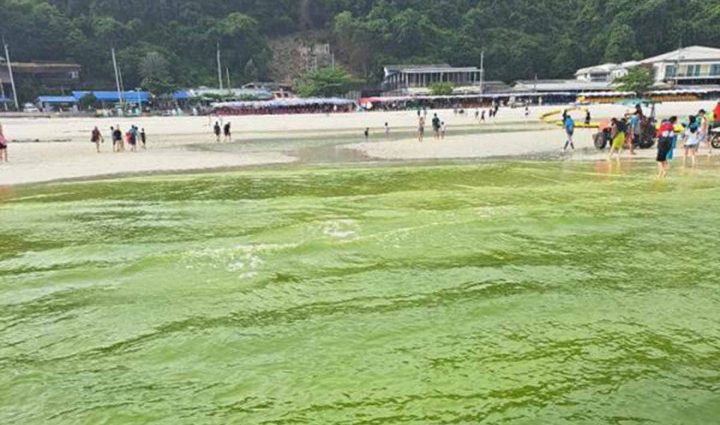Plankton bloom pose no harm to humans
PUBLISHED : 31 Jul 2023 at 06:21

CHON BURI: Wastewater discharged from Koh Lan is the major cause of the plankton bloom that turned the sea smelly and green, said the Department of Marine and Coastal Resources (DMCR) on Sunday.
The DMCR inspection at Ta Waen Beach on Koh Lan came after the Facebook page “We Love Pattaya” posted pictures of unusually green seawater around the popular island, which is located 7 kilometres off the coast of Pattaya Beach.
According to DMCR deputy director Apichai Aekwanakul, the phenomenon was first spotted on Saturday and authorities advised against swimming due to the reduced visibility.
Mr Apichai said that the colour change is caused by Noctiluca scintillans, a phytoplankton that is non-toxic and normally found in an annual bloom along the eastern seaboard.
Continuous wastewater discharging into the sea on Koh Lan is believed to be the primary cause, he said.
Mr Apichai explained that the bloom tended to be stronger in the rainy season as downpours tend to wash nitrogen and phosphorus from wastewater into the aquatic system and cause excessive growth of the plankton, leading to the green colour and unpleasant odour.
The DMCR and related agencies will investigate and conduct further research possible health problems and the need for warnings to be issued, he said.
The plankton bloom, along with the off-season spawning of leatherback turtles in Phuket, are both oceanic phenomena that lecturer Thon Thamrongnawasawat from Kasetsart University’s Faculty of Fisheries suggested those interested in the environment keep an eye on closely.
According to a post made on his Facebook page, both are symptomatic of changes to the marine environment caused by natural fluctuations and human activity.
Regarding the plankton bloom, Mr Thon said that it was abnormal to see the phenomenon during the period when the impact of El Nino is about to intensify.
Normally a decline in rainfall would lower the chances of plankton bloom occurring, according to Mr Thon, yet the opposite has been observed this year, especially along the Eastern Economic Corridor (EEC) in the upper part of the Gulf of Thailand.
This abnormality is becoming more frequent due to global “boiling”, as defined by the United Nations recently, and Mr Thon added that the plankton bloom might affect tourism, especially in high season.

